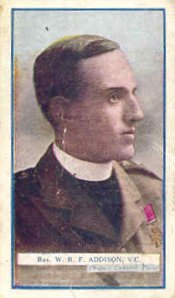William Addison (VC) facts for kids
Quick facts for kids
William Robert Fountaine Addison
|
|
|---|---|
 |
|
| Born | 16 September 1883 North Warnborough, Hampshire |
| Died | 7 January 1962 (aged 78) St Leonards-on-Sea, Sussex |
| Buried |
Brookwood Cemetery
(51°17′54″N 0°37′35″W / 51.298319°N 0.626347°W) |
| Allegiance | |
| Service/ |
|
| Years of service | 1914–1938 1939–1942 |
| Rank | Chaplain |
| Unit | Army Chaplain's Department |
| Battles/wars | First World War Second World War |
| Awards | Victoria Cross Order of St. George IV class (Russia) |
William Robert Fountaine Addison (born September 18, 1883 – died January 7, 1962) was a brave English chaplain. He received the Victoria Cross, which is the highest award for courage in battle for British and Commonwealth soldiers. This special medal is given for amazing bravery when facing the enemy.
Contents
Early Life and Becoming a Chaplain
William Addison grew up in England. He went to Robert Mays School in Odiham. When he was a young man, he worked as a lumberjack in Canada. This means he cut down trees for wood.
Later, he decided to study at Salisbury Theological College. In 1913, he became a priest, which is called being ordained. He then worked as a curate at St Edmund's Church in Salisbury. A curate is a priest who helps in a church parish.
Bravery in World War I
When the First World War started, William Addison joined the army. He became a chaplain, which is like a spiritual leader or priest for soldiers. He was part of the Army Chaplain's Department.
His incredible bravery happened on April 9, 1916. This was during a battle in a place called Sanna-i-Yat in Mesopotamia. He was given the Victoria Cross for what he did that day.
Saving Wounded Soldiers
During heavy fighting, William Addison showed amazing courage. He carried a wounded soldier to safety in a trench. A trench is a long, narrow ditch dug in the ground for soldiers to hide in.
He also helped several other wounded soldiers get to the same safe place. He even bandaged their wounds while under heavy rifle and machine gun fire. This means bullets were flying all around him.
Encouraging Others
Besides helping soldiers himself, William Addison's actions inspired others. His great example and his complete disregard for his own safety encouraged the stretcher-bearers. Stretcher-bearers are people who carry wounded soldiers on stretchers. Because of him, they went forward into the dangerous battle zone to collect more wounded soldiers.
Life After the Wars
After the First World War, William Addison continued to serve as an army chaplain. He worked in many different places around the world. These included Malta, Khartoum in Sudan, and Shanghai in China. He also served at army bases in England.
From 1934 to 1938, he was a Senior Chaplain. Then he left the army and became a parish priest again. He was the Rector (head priest) of Coltishall with Great Hautbois in Norfolk from 1938 to 1958.
However, when World War II began, he returned to the army. He once again served as a Senior Chaplain. William Addison passed away in St Leonards-on-Sea in East Sussex. He is buried in Brookwood Cemetery in Surrey.
Remembering His Bravery
You can see a copy of William Addison's medals today. They are on display at the Museum of Army Chaplaincy. Another set is at Sarum College in Salisbury.
Images for kids


